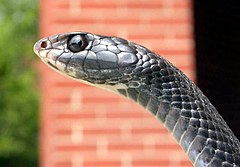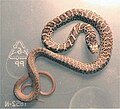Eastern racer
| Coluber constrictor | |
|---|---|

| |
| Buttermilk Racer Coluber constrictor anthicus | |
| Scientific classification | |
| Kingdom: | |
| Phylum: | |
| Class: | |
| Order: | |
| Suborder: | |
| Family: | |
| Genus: | |
| Species: | C. constrictor
|
| Binomial name | |
| Coluber constrictor | |
| Synonyms | |
|
Bascanion constrictor | |
Coluber constrictor is a species of non-venomous, colubrid snakes commonly referred to as the eastern racers. They are primarily found throughout the United States, east of the Rocky Mountains, but they range north into Canada, and south into Mexico, Guatemala and Belize. There are currently 10 recognized subspecies.
Description
Racers typically grow to around 3½ feet (107 cm) long, but some subspecies are capable of attaining lengths of 6 feet (1.8 m). Their patterns vary widely between subspecies. Most are solid colored as their common names imply, black, brown, blue or green. All subspecies have a lighter colored underbelly: white, a light tan or yellow in color. Juveniles are often more strikingly patterned, with green skin, orange tail, a red stripe going around every 1.3 inches, and a yellow nose.
Behavior
Racers are fast moving, highly active, diurnal snakes. Their diet consists primarily of rodents, frogs, and lizards, and some subspecies are known to climb trees in order to eat eggs and young birds. Juveniles often consume soft-bodied insects, such as crickets and moths. Despite their scientific name of constrictor, they do not really employ constriction, instead simply subduing struggling prey by pinning it bodily, pressing one or two coils against it to hold it in place instead of actually suffocating it. Most smaller prey items are simply swallowed alive.
Racers typically prefer to make use of their speed to flee when confronted by a potential predator, and if handled they generally do not hesitate to bite, and sometimes release a foul smelling musk from their cloaca. They are curious snakes with excellent vision, and are sometimes seen raising their head above the height of the grass they are crawling in to view what is around them.
Habitat
Most racers prefer open, grassland type habitat where their keen eyesight and speed can be readily used, but they are also found in light forest and even semi-arid regions. They are usually not far from an area of cover to hide in.
Reproduction
Mating takes place in the spring, from April until early June. Around a month later the female will lay anywhere from 3 to 30 eggs in a hidden nest site such as a hollow log, an abandoned rodent burrow, or under a rock. The 8-10" long juvenile racers hatch in the early fall. Maturity is reached in approximately 2 years. Racers have been known to lay their eggs in communal sites, where a number of snakes, even those from other species, all lay their eggs together.
Subspecies

- Buttermilk Racer, Coluber constrictor anthicus (Cope, 1862)
- Northern Black Racer, Coluber constrictor constrictor (Linnaeus, 1758)
- Tan Racer, Coluber constrictor etheridgei (Wilson, 1970)
- Eastern Yellowbelly Racer, Coluber constrictor flaviventris (Say, 1823)
- Blue Racer, Coluber constrictor foxii (Baird & Girard, 1853)
- Brownchin Racer, Coluber constrictor helvigularis (Auffenberg, 1955)
- Blackmask Racer, Coluber constrictor latrunculus (Wilson, 1970)
- Mexican Racer, Coluber constrictor oaxaca (Jan, 1863)
- Everglades Racer, Coluber constrictor paludicola (Auffenberg & Babbitt, 1955)
- Southern Black Racer, Coluber constrictor priapus (Dunn & Wood, 1939)
Gallery
-
Juvenile Yellowbelly Racer, C. c. flaviventris
-
Adult Yellowbelly Racer, C. c. flaviventris
-
Northern Black Racer, C. c. constrictor
-
Northern Black Racer, C. c. constrictor in typical habitat
-
Black Rat Snake often confused with Racer, E. obsoleta obsoleta
References
- Racer - Coluber constrictor Species account from the Iowa Reptile and Amphibian Field Guide





